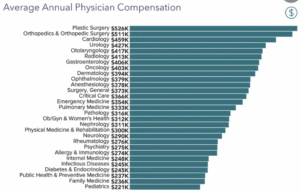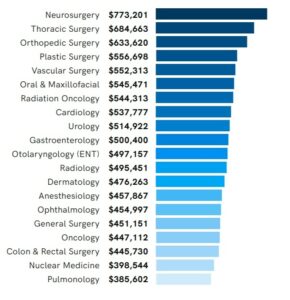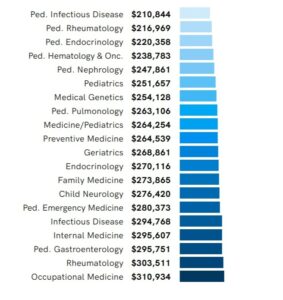

How Much Compensation Does a Doctor Get?
Despite the COVID-19 epidemic which exacerbated burnout among doctors, physician salaries rose more than twice as much in 2021 than they did the previous year, according to Doximity research based on survey responses from over 40,000 US doctors. Doctors earned an average of 3.8% more in 2021 than they did in 2020, according to the survey.
Even though salaries for physicians increased last year, they still suffered a drop in real income (as did in most other occupations, due to inflation). Inflation in July 2022 was 9.1%, which unfortunately negates the rise in doctor salaries across the country.
According to a Doximity survey of 1,000 doctors released in August 2022, more than half of those surveyed are either delaying retirement (40%) or cutting costs (15%) due to the economy.
The data from Doximity reveals that male doctors earn, on average, $122,000 more than their female colleagues annually, and over their careers, $2 million more. This gender gap may be the reason behind the increased rate of physician burnout for female doctors.
How much does the average doctor earn?
It’s not necessarily useful to know the average doctor’s salary.
Doximity’s report on pediatric infectious disease specialists’ salaries illustrates how out of whack things can get. The average specialist makes $492,023 annually, whereas the average neurosurgeon makes $773,201. This disparity, however, is largely irrelevant. According to Medscape, the average primary care physician makes $242,000, while the average specialist makes $344,000. This comparison reveals a pretty big gap.
It’s likely more useful to know the average in a doctor’s speciality than the salary of a physician in general.
The speciality determines the doctor’s salary.
It’s interesting to note that salary surveys are rubbish in and rubbish out. There is a great deal of variation in speciality pay averages between surveys. Before we dive into the Doximity numbers, let’s compare them with those from the Medscape survey published eight months ago.

Image source: Medscape
According to Medscape, pediatricians make $221,000 per year, while Doximity says they make $251,000. That’s a 14% difference. According to Medscape, orthopedists earn $511,000 annually, while Doximity puts that number at $633,000, 24% more. How can new graduates or even experienced doctors negotiate a contract with so many variances in between the averages (other than, obviously, using the Doximity survey when negotiating)? Furthermore, what if you’re a OB/GYN physician or a psychiatrist or an emergency medicine physician or a neurologist (Doximity didn’t survey these specialities, despite their prevalence)? If you’re a neurosurgeon or a CT surgeon and Medscape doesn’t mention your speciality, do you have to pay $965 for MGMA data? The big question still remains, is that data any better than these surveys?
Most Paid Doctors
The Doximity survey provides information on the highest-paid and lowest-paid doctors. Surgical and procedural specialties are the most well-paid, and doctors who earn the least practice primary care and pediatrics.
Here is what Doximity discovered:

Image source: Doximity
Lowest Paid Doctors
Here are the lowest-paying specialties:

Image source: Doximity
Remember that these figures represent the highest and lowest physician compensation amounts for the 20 most frequent specialties. Psychiatry, adult emergency medicine, and allergy and immunology, for example, are likely to have salary ranges from around $311,000 to around $384,000.
Despite the fact that many cosmetic surgeries had to be curtailed during the pandemic, plastic surgeons continue to make a lot of money, along with oncologists and surgeons. Salary reductions are slightly lower for dermatology, one of the toughest specialties to match into.
Doctors’ Salaries by State
Doctors living in lower-cost-of-living areas and drawing higher salaries in areas where there is a higher need for physicians are closer to financial independence. Geographic arbitrage is real.
In states like Alabama, Kentucky, Oklahoma, Indiana, and Missouri, doctors make the highest wages. Of all the flyover states, these five have the highest doctor pay, and none of them are among the 15 states with the most people.
Obviously, a doctor living in Florence, Alabama, will have a lower cost of living than one living in New York City. If we’re practicing geographic arbitrage, an Alabama doctor probably earns more than a New York City physician does.
Doctors’ pay raises are on the rise.
According to Doximity, here are the top-five specialties with the biggest salary increases in 2021.
- Preventative Medicine: $264,539 (a 12.6% increase)
- Hematology: $357,292 (a 12.2% increase)
- Nuclear Medicine: $398,544 (a 10.4% increase)
- Pediatric Nephrology: $247,861 (a 9.5% increase)
- Occupational Medicine: $310,934 (an 8.4% increase)
The practice setting compensation also widely varies. For instance, working in a single-specialty group instead of the government can be a big boost to a doctor’s income.
- Single Specialty Group: $442,024
- Multi-specialty Group: $424,312
- Solo Practice: $415,678
- Hospital: $399,282
- Industry/Pharmaceutical: $395,560
- Health System/IDN/ACO: $394,538
- Health Maintenance Organization: $374,571
- Academic: $350,232
- Urgent Care Center/Chain: $267,516
- Government: $264,546
Start Your Research Process.
Find a Dr. Home Finance Verified Banker Today.
We are not a lending company. We help you find the best physician loan on the market.
You can find doctor loans through an online tool like Dr. HomeFinance that compares multiple lenders for you. Simply select which state you are looking at living in and get the best physician mortgage you can.
Apply now to begin the process of owning your dream home.


